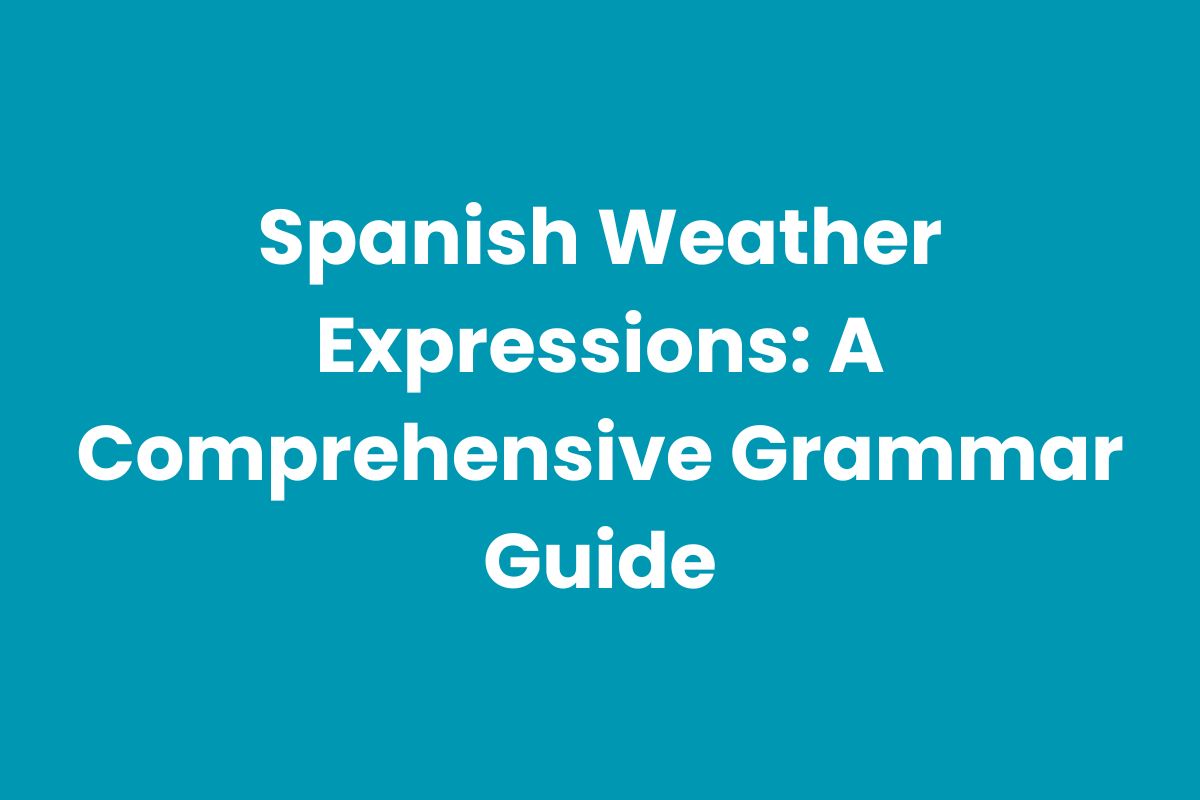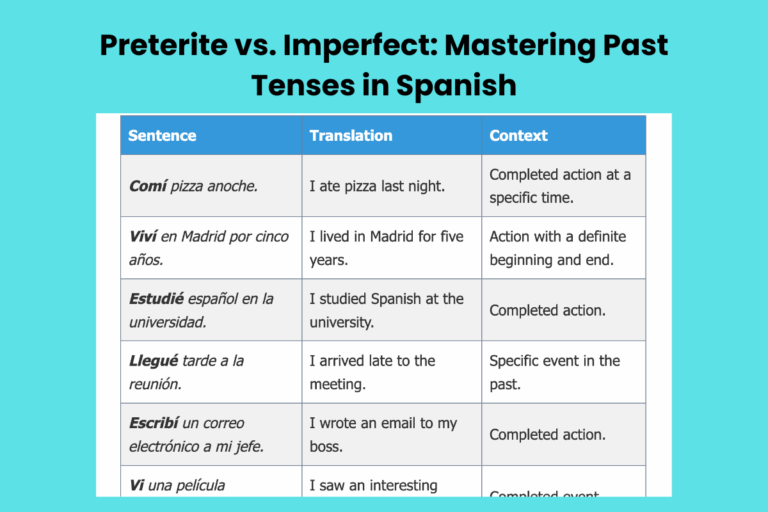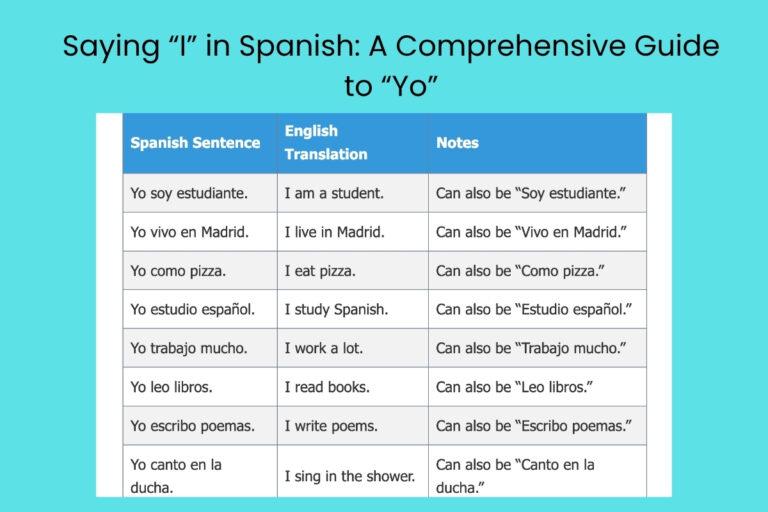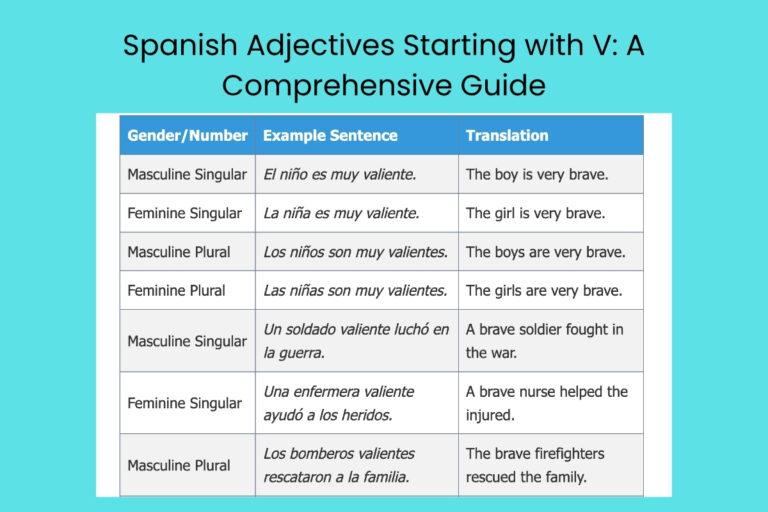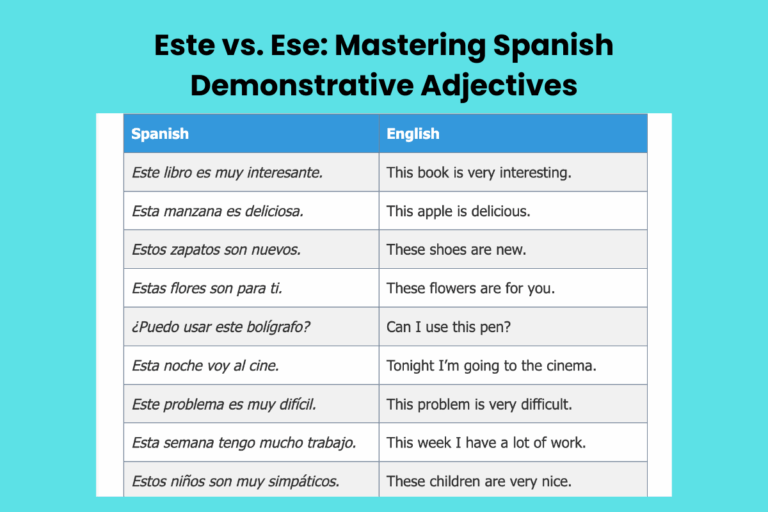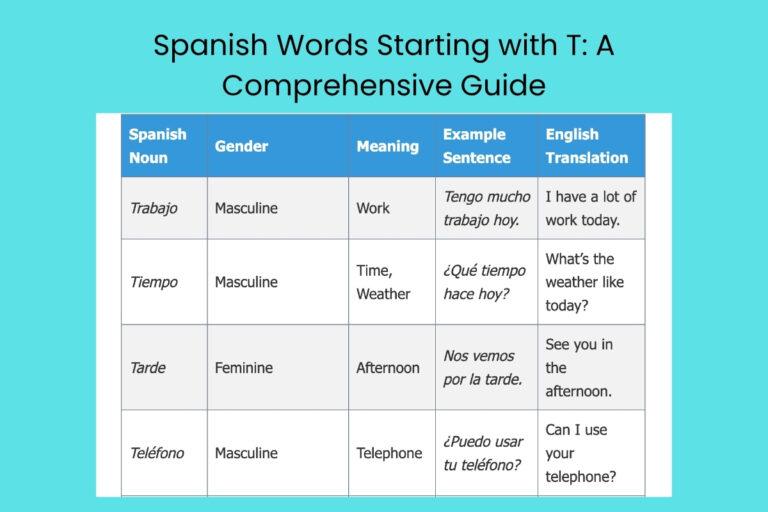Spanish Weather Expressions: A Comprehensive Grammar Guide
Understanding how to talk about the weather is a fundamental skill in any language, and Spanish is no exception. Mastering Spanish weather expressions allows you to engage in everyday conversations, understand news reports, and describe your environment accurately.
This guide provides a detailed exploration of Spanish weather expressions, covering their grammar, usage, and common pitfalls. Whether you’re a beginner or an advanced learner, this article will equip you with the knowledge and practice you need to confidently discuss the weather in Spanish.
Table of Contents
- Introduction
- Definition of Spanish Weather Expressions
- Structural Breakdown
- Types and Categories of Weather Expressions
- Examples of Spanish Weather Expressions
- Usage Rules for Spanish Weather Expressions
- Common Mistakes in Spanish Weather Expressions
- Practice Exercises
- Advanced Topics
- Frequently Asked Questions
- Conclusion
Definition of Spanish Weather Expressions
Spanish weather expressions are phrases and grammatical structures used to describe atmospheric conditions, temperature, precipitation, and wind. These expressions often involve impersonal verbs, specific nouns, and particular verb tenses.
Understanding these expressions is essential for effective communication about the environment and daily life.
Weather expressions in Spanish can be categorized based on the aspect of the weather they describe. For example, some expressions describe the general state of the sky (e.g., “Está nublado” – It’s cloudy), while others focus on specific phenomena (e.g., “Está lloviendo” – It’s raining). The grammatical structure often involves impersonal verbs like “hacer” (to do/make) and “haber” (to have/there is/are), as well as the verbs “ser” (to be) and “estar” (to be) used in specific contexts.
Structural Breakdown
Impersonal Verbs
Impersonal verbs are verbs that are only conjugated in the third-person singular form. They do not refer to a specific subject and are commonly used in weather expressions. The most common impersonal verbs are “hacer” and “haber.”
The verb “hacer” is used to describe the temperature or the state of the weather in general. For example, “Hace frío” (It’s cold) and “Hace calor” (It’s hot). The verb “haber”, in its impersonal form “hay,” is used to indicate the existence of something, such as “Hay niebla” (There is fog).
Ser vs. Estar
The verbs “ser” and “estar” both translate to “to be” in English, but they are used in different contexts. In weather expressions, “ser” is typically used to describe inherent characteristics or qualities, while “estar” is used to describe temporary states or conditions.
For example, “El cielo está nublado” (The sky is cloudy) uses “estar” because the cloudiness is a temporary condition. However, you might use “ser” in a more descriptive or poetic context that emphasizes a permanent characteristic, though this is less common for weather.
Noun Usage
Nouns related to weather, such as “lluvia” (rain), “nieve” (snow), “viento” (wind), and “sol” (sun), are essential for describing weather conditions. These nouns are often used with verbs like “hay” or as the subject of verbs like “caer” (to fall) when describing precipitation.
For instance, “Hay lluvia” (There is rain) indicates the presence of rain, while “La nieve cae” (The snow is falling) describes the action of snow falling. Understanding the gender of these nouns (masculine or feminine) is crucial for correct agreement with articles and adjectives.
Types and Categories of Weather Expressions
Atmospheric Conditions
This category includes expressions that describe the general state of the atmosphere, such as cloudiness, fog, and visibility. These conditions often affect daily activities and are important to communicate.
Examples include: “Está despejado” (It’s clear), “Está nublado” (It’s cloudy), “Hay niebla” (There is fog), and “Hay bruma” (There is mist).
Temperature
Expressions related to temperature describe how hot or cold it is. These expressions often use the verb “hacer” followed by an adjective indicating the temperature level.
Examples include: “Hace calor” (It’s hot), “Hace frío” (It’s cold), “Hace fresco” (It’s cool), and “Hace sol” (It’s sunny).
Precipitation
This category covers expressions that describe different forms of precipitation, such as rain, snow, hail, and sleet. These expressions often use verbs like “llover” (to rain), “nevar” (to snow), and “caer” (to fall).
Examples include: “Está lloviendo” (It’s raining), “Está nevando” (It’s snowing), “Cae granizo” (Hail is falling), and “Llueve a cántaros” (It’s raining cats and dogs).
Wind
Expressions describing wind conditions indicate the presence and intensity of wind. These expressions often use the verb “hacer” or nouns like “viento” (wind).
Examples include: “Hace viento” (It’s windy), “Corre viento” (The wind is blowing), “Hay una brisa” (There is a breeze), and “El viento es fuerte” (The wind is strong).
Examples of Spanish Weather Expressions
Atmospheric Conditions Examples
The following table provides examples of expressions describing atmospheric conditions in Spanish, along with their English translations.
| Spanish | English |
|---|---|
| Está despejado. | It’s clear. |
| Está nublado. | It’s cloudy. |
| Hay niebla. | There is fog. |
| Hay bruma. | There is mist. |
| El cielo está cubierto. | The sky is overcast. |
| Se ve el arcoíris. | You can see the rainbow. |
| Hay nubes bajas. | There are low clouds. |
| El cielo está gris. | The sky is gray. |
| Hay mucha humedad. | There is a lot of humidity. |
| La visibilidad es baja. | The visibility is low. |
| El cielo está oscuro. | The sky is dark. |
| Hay neblina. | There is haze. |
| El día está soleado. | The day is sunny. |
| Está amaneciendo. | It’s dawning. |
| Está atardeciendo. | It’s getting dark. |
| El cielo está tormentoso. | The sky is stormy. |
| Hay relámpagos. | There are lightning flashes. |
| Hay truenos. | There is thunder. |
| Se formó un remolino. | A whirlwind formed. |
| El aire está denso. | The air is heavy. |
| Hay un eclipse solar. | There is a solar eclipse. |
| Hay un eclipse lunar. | There is a lunar eclipse. |
| El cielo se está aclarando. | The sky is clearing. |
| El cielo se está oscureciendo. | The sky is darkening. |
| Hay un halo alrededor del sol. | There is a halo around the sun. |
| Hay un halo alrededor de la luna. | There is a halo around the moon. |
| La atmósfera está pesada. | The atmosphere is heavy. |
Temperature Examples
This table provides examples of expressions describing temperature in Spanish, along with their English translations. Note the use of “hacer” with temperature descriptions.
| Spanish | English |
|---|---|
| Hace calor. | It’s hot. |
| Hace frío. | It’s cold. |
| Hace fresco. | It’s cool. |
| Hace sol. | It’s sunny. |
| Hace bochorno. | It’s muggy. |
| Hace un tiempo agradable. | The weather is pleasant. |
| Hace un tiempo horrible. | The weather is horrible. |
| Hace mucho calor. | It’s very hot. |
| Hace mucho frío. | It’s very cold. |
| Hace un calor sofocante. | It’s sweltering. |
| La temperatura es alta. | The temperature is high. |
| La temperatura es baja. | The temperature is low. |
| Estamos a 25 grados. | We are at 25 degrees. |
| La temperatura ha bajado. | The temperature has dropped. |
| La temperatura ha subido. | The temperature has risen. |
| Hay una ola de calor. | There is a heat wave. |
| Hay una ola de frío. | There is a cold wave. |
| Se congela todo. | Everything is freezing. |
| Estoy helado/a. | I’m freezing. |
| Estoy sudando. | I’m sweating. |
| El clima es templado. | The climate is mild. |
| El clima es seco. | The climate is dry. |
| El clima es húmedo. | The climate is humid. |
| La sensación térmica es alta. | The feels like temperature is high. |
| La sensación térmica es baja. | The feels like temperature is low. |
| El tiempo está cambiando. | The weather is changing. |
| El tiempo está empeorando. | The weather is getting worse. |
Precipitation Examples
The following table provides examples of expressions describing precipitation in Spanish, along with their English translations.
| Spanish | English |
|---|---|
| Está lloviendo. | It’s raining. |
| Está nevando. | It’s snowing. |
| Cae granizo. | Hail is falling. |
| Llueve a cántaros. | It’s raining cats and dogs. |
| Está chispeando. | It’s drizzling. |
| Hay una tormenta. | There is a storm. |
| Hay una tormenta de nieve. | There is a snowstorm. |
| Hay una tormenta de arena. | There is a sandstorm. |
| Está diluviando. | It’s pouring. |
| La lluvia es fuerte. | The rain is heavy. |
| La nieve es blanda. | The snow is soft. |
| Cae aguanieve. | It’s sleeting. |
| Hay inundaciones. | There are floods. |
| El río se desbordó. | The river overflowed. |
| Hay charcos. | There are puddles. |
| El granizo es pequeño. | The hail is small. |
| El granizo es grande. | The hail is large. |
| La lluvia ha parado. | The rain has stopped. |
| La nieve se está derritiendo. | The snow is melting. |
| Hay escarcha. | There is frost. |
| La carretera está helada. | The road is icy. |
| Hay mucho barro. | There is a lot of mud. |
| La humedad es alta. | The humidity is high. |
| Está cayendo un chaparrón. | A downpour is falling. |
| El cielo amenaza lluvia. | The sky threatens rain. |
| Está goteando. | It’s dripping. |
| Llovizna. | Drizzle. |
Wind Examples
This table provides examples of expressions describing wind conditions in Spanish, along with their English translations.
| Spanish | English |
|---|---|
| Hace viento. | It’s windy. |
| Corre viento. | The wind is blowing. |
| Hay una brisa. | There is a breeze. |
| El viento es fuerte. | The wind is strong. |
| El viento es suave. | The wind is gentle. |
| El viento está soplando. | The wind is blowing. |
| Hay una ráfaga de viento. | There is a gust of wind. |
| El viento amainó. | The wind died down. |
| El viento está aumentando. | The wind is increasing. |
| Hay un vendaval. | There is a gale. |
| El viento del norte. | The north wind. |
| El viento del sur. | The south wind. |
| El viento del este. | The east wind. |
| El viento del oeste. | The west wind. |
| El viento huracanado. | The hurricane-force wind. |
| El viento está cambiando de dirección. | The wind is changing direction. |
| El viento levanta polvo. | The wind is stirring up dust. |
| El viento es helado. | The wind is icy. |
| Sopla una brisa marina. | A sea breeze is blowing. |
| Sopla un viento terrestre. | A land breeze is blowing. |
| El viento silba. | The wind is whistling. |
| El viento arrastra las hojas. | The wind is carrying the leaves. |
| El viento tumba árboles. | The wind is knocking down trees. |
| El viento es constante. | The wind is constant. |
| El viento es variable. | The wind is variable. |
| El viento azota la costa. | The wind lashes the coast. |
| El viento arrecia. | The wind is picking up. |
Idiomatic Weather Expressions
Spanish, like many languages, has idiomatic expressions related to weather. These expressions often carry figurative meanings beyond their literal interpretations.
| Spanish | English | Meaning |
|---|---|---|
| Estar como agua para chocolate. | To be like water for chocolate. | To be very angry or agitated. |
| Hacer un día de perros. | To be a dog’s day. | To be a very bad weather day. |
| Llover a mares. | To rain seas. | To rain heavily. |
| Tener la cabeza en las nubes. | To have the head in the clouds. | To be absent-minded or daydreaming. |
| Ver las estrellas. | To see the stars. | To experience a lot of pain. |
| Después de la tormenta siempre llega la calma. | After the storm always comes the calm. | Things will get better after a difficult period. |
| Costar un ojo de la cara. | To cost an eye of the face. | To be very expensive. |
| Estar en las nubes. | To be in the clouds. | To be unaware of one’s surroundings. |
| Nació con buena estrella. | Born under a lucky star. | Someone who is lucky. |
Usage Rules for Spanish Weather Expressions
Agreement
Nouns and adjectives must agree in gender and number. For example, if you are describing the “lluvia” (rain), which is feminine, any adjectives used to describe it must also be feminine.
Example: “La lluvia fuerte” (The heavy rain). Here, both “lluvia” and “fuerte” are feminine singular.
Verb Tenses
The verb tense used depends on the time frame you are referring to. Use the present tense to describe current weather conditions, the past tense to describe past weather, and the future tense to describe future weather.
Examples: “Está lloviendo” (It is raining – present), “Ayer llovió” (Yesterday it rained – past), “Mañana lloverá” (Tomorrow it will rain – future).
Prepositions
Prepositions are important for specifying locations and times when describing weather. Common prepositions include “en” (in/on), “a” (to/at), and “durante” (during).
Examples: “En verano hace calor” (In summer it is hot), “A las tres de la tarde llovió” (At three in the afternoon it rained), “Durante la noche hubo niebla” (During the night there was fog).
Common Mistakes in Spanish Weather Expressions
One common mistake is using “ser” instead of “estar” for temporary conditions. For example, saying “El cielo es nublado” is incorrect; the correct form is “El cielo está nublado.”
Another mistake is using the wrong verb with temperature expressions. It is incorrect to say “Es calor”; the correct form is “Hace calor.” Remember that “hacer” is used to describe the temperature.
Finally, incorrect gender agreement is a frequent error. Ensure that nouns and adjectives agree in gender and number. For example, it’s incorrect to say “El lluvia fuerte”; the correct form is “La lluvia fuerte.”
Correct: Hace frío. (It’s cold.)
Incorrect: Es frío. (It’s cold.)
Correct: La nieve es blanca. (The snow is white.)
Incorrect: El nieve es blanca. (The snow is white.)
Practice Exercises
Exercise 1: Fill in the Blanks
Fill in the blanks with the correct Spanish weather expression.
| Question | Answer |
|---|---|
| Hoy ________ mucho sol. | Hoy hace mucho sol. |
| ________ lloviendo muy fuerte. | Está lloviendo muy fuerte. |
| ________ niebla en la mañana. | Hay niebla en la mañana. |
| El cielo ________ nublado hoy. | El cielo está nublado hoy. |
| ________ viento. | Hace viento. |
| ________ a cántaros. | Llueve a cántaros. |
| ________ fresco por la noche. | Hace fresco por la noche. |
| ________ nieve en las montañas. | Hay nieve en las montañas. |
| La temperatura ________ baja. | La temperatura es baja. |
| ________ una tormenta. | Hay una tormenta. |
Exercise 2: Translation
Translate the following English sentences into Spanish.
| Question | Answer |
|---|---|
| It is hot today. | Hace calor hoy. |
| It is snowing outside. | Está nevando afuera. |
| There is a lot of wind. | Hay mucho viento. |
| The sky is clear. | El cielo está despejado. |
| It’s raining cats and dogs. | Llueve a cántaros. |
| It’s cold in winter. | Hace frío en invierno. |
| There is fog in the city. | Hay niebla en la ciudad. |
| The weather is pleasant. | Hace un tiempo agradable. |
| The temperature is high. | La temperatura es alta. |
| There is a storm coming. | Se acerca una tormenta. |
Exercise 3: Error Correction
Identify and correct the errors in the following Spanish sentences.
| Question | Answer |
|---|---|
| Es viento. | Hace viento. |
| El cielo ser nublado. | El cielo está nublado. |
| Hay mucho calores. | Hace mucho calor. |
| La nieve ser blanca. | La nieve es blanca. |
| Está hacer frío. | Hace frío. |
| El lluvia es fuerte. | La lluvia es fuerte. |
| Hay un viento fuerte hoy. | Hay un viento fuerte hoy (Correct) |
| Ayer es lloviendo. | Ayer estuvo lloviendo. |
| Hace niebla. | Hay niebla. |
| El temperatura es bajo. | La temperatura es baja. |
Advanced Topics
The Subjunctive Mood
The subjunctive mood is used to express doubt, possibility, or subjectivity. In weather expressions, it might be used when expressing uncertainty about the weather.
Example: “No creo que nieve mañana” (I don’t think it will snow tomorrow). Here, “nieve” is in the subjunctive mood because there is doubt about whether it will snow.
Regional Variations
Spanish has regional variations in vocabulary and expressions. Some regions may use different words or phrases to describe the same weather conditions.
For example, in some regions, the word “chaparron” might be more commonly used to describe a heavy downpour than in others. Being aware of these regional variations can enhance your understanding and communication skills.
Frequently Asked Questions
- How do I say “What’s the weather like?” in Spanish?
You can say “¿Qué tiempo hace?” or “¿Cómo está el tiempo?” Both phrases are common and widely understood.
- When do I use “ser” vs. “estar” for weather descriptions?
Use “estar” for temporary conditions like cloudiness (“El cielo está nublado”). “Ser” is rarely used in common weather descriptions, but might appear in more poetic or descriptive contexts to emphasize inherent qualities.
- How do I describe the temperature in Celsius and Fahrenheit?
You can say “Estamos a 25 grados Celsius” or “Estamos a 77 grados Fahrenheit.” Be sure to specify the scale for clarity.
- What is the difference between “niebla” and “bruma”?
“Niebla” is fog, which is denser and reduces visibility more significantly. “Bruma” is mist or haze, which is lighter and less dense.
- How do I say “It’s freezing” in Spanish?
You can say “Estoy helado/a” (if referring to yourself) or “Se congela todo” (if referring to things freezing).
- What are some common idioms related to weather in Spanish?
Some common idioms include “Hacer un día de perros” (To be a dog’s day – referring to bad weather) and “Llover a mares” (To rain seas – meaning to rain heavily).
- How do I ask if it is going to rain?
You can ask “¿Va a llover?” (Is it going to rain?) or “¿Lloverá?” (Will it rain?).
- How can I improve my understanding of Spanish weather expressions?
Practice using these expressions in conversations, listen to Spanish weather forecasts, and read Spanish news articles about the weather. Pay attention to how native speakers describe weather conditions.
- Is there a difference between “clima” and “tiempo”?
Yes, “clima” refers to the average weather conditions of a region over a long period, while “tiempo” refers to the current or short-term weather conditions.
- How do I describe a hurricane or tornado in Spanish?
For a hurricane, you can say “Hay un huracán.” For a tornado, you can say “Hay un tornado” or “Hay un torbellino.”
Conclusion
Mastering Spanish weather expressions is a valuable step in achieving fluency and understanding the nuances of the language. By understanding the grammar, vocabulary, and usage rules discussed in this guide, you can confidently describe weather conditions and engage in everyday conversations.
Remember to practice regularly and pay attention to how native speakers use these expressions in real-life contexts.
Continue to expand your vocabulary and explore regional variations to further enhance your understanding. Don’t be afraid to make mistakes; they are a natural part of the learning process.
With consistent effort and practice, you’ll be able to discuss the weather in Spanish with ease and confidence.

